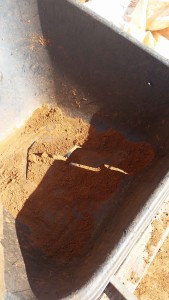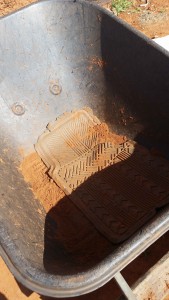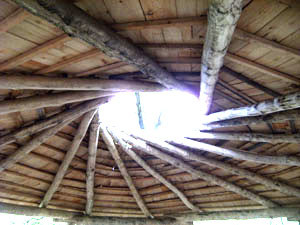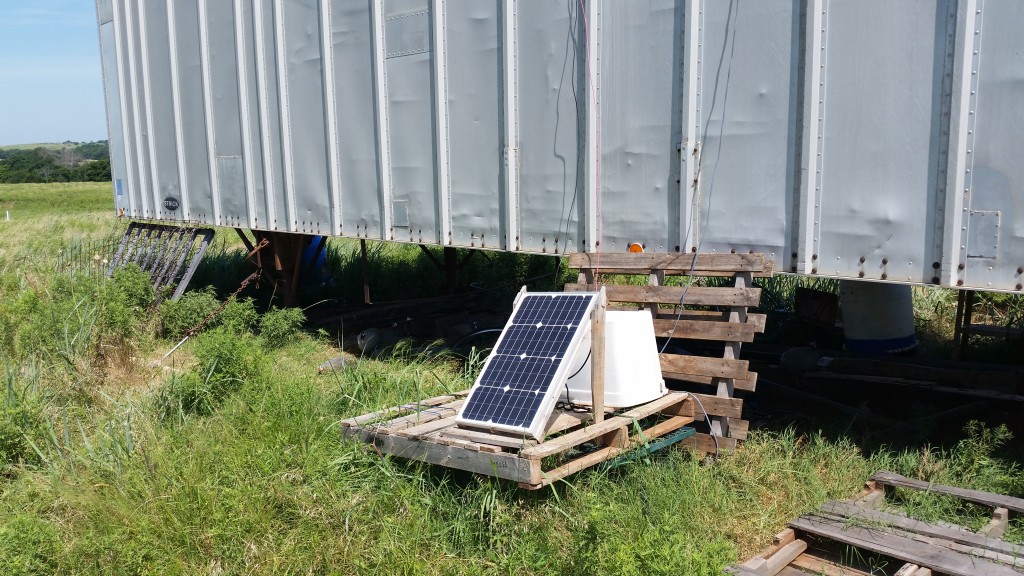Reflections on July, 2015: Wall Completion!
As far as Oklahoma summers go, this one has been the nicest yet. It actually rained around the 4th of July, around the middle of the month, a little shower on the 21st, and then a nice booming thunderstorm on the 31st. This rain brought comfortable clouds that shaded the sun for a few days here and there, but it also brought the expected humidity and mosquitoes. Lots of them. Nights in the semi-trailer have been nearly unbearable at times. It is difficult to sleep, even after a long hard day at work, when I lay down in bed and its 78 degrees and there is no breeze and the mosquitoes make that notorious high-pitched buzz right in my ear. Those maddening little creatures remind me of a paper I wrote in college, in an ecology class where we had to decide whether or not it would be detrimental to any other species or ecosystems if we eradicated the mosquito. Besides a few species of bat, and the pitcher plant, there are no species who rely on the mosquito for a large part of their diet, and given the disease threat they spread, I figured that hell yes, we should by all means eradicate the mosquito. After further research though, I learned that they are actually pollinators, and even if their pollination services are minuscule, they are necessary. We simply can’t risk upsetting the balance of nature.
On the upside, insects that we’ve seen remarkably less of this year, either do to raising guineas, or the rain, or a combination of both, are ticks, fleas, and grasshoppers. I know that the guineas can eat grasshoppers until the cows come home, and quite literally, they do. But do they also eat ticks and fleas? Knock on wood, our dogs haven’t been bothered by fleas this year! Ticks are there, with their big engorged disgusting bodies, but they are few and far between. My praise goes to the guinea fowl, who, despite their annoying boisterous calls, have kept our insect problems to a minimum.
Which is why I am sad to report that we lost some baby guineas. In the first week of July, Aaron and I were so excited to see that the two darker guineas, a male and a female, had 4 keets following them around. I managed one picture of the sweet little puff-balls.

The parents were very protective. That night, the temperature dropped and it rained quite heavily. The next day, the keets were nowhere to be found. We presume that while we were in Illinois for 3 weeks, a guinea hen became broody and with no human distractions, she sat on her nest and was able to hatch the babies. When we got back, we wanted to be sure we still had all 6 of them, so we called and threw out some wheat berries. Now, we have decided that leaving them alone is probably the best bet. We have told our 9 year old that despite the curiosity of knowing where the nests are, we need to not seek them out because they are easily distracted from their nesting duties. However, the laying and nesting season is still in full swing, so I think we still have a chance at increasing our flock of all-natural insect control.
Remember how I told you my dad brought us some raspberries last year, and the grasshoppers ate them like candy? Well, he brought me another plant this year and I am very happy to report it has not been eaten! Yet. I have been checking it every week or so and watering and adding compost and mulch, because I really want this one to take hold. Raspberries are my all-time favorite fruit.

And on to beekeeper news. Part of top bar hive beekeeping is regular maintenance. Sometimes the bees will use propolis to connect the edges of the comb to the sides of the hive. The top bar hive beekeeper must pull the combs out and make sure to disconnect those, otherwise the combs won’t come out, or they’ll rip and create angry bees and a large mess. This regular maintenance also includes checking on bee behavior and how much honey is being produced and how many combs contain brood and how many contain honey. Its kind of like a regular doctor check-up. So, we attempted this maintenance this July and found ourselves in the predicament of some very protective bees. We were able to disconnect most of those comb-to-hive connections, but the bees got very annoyed with our prodding. We had to simply walk away from the hive several times to allow time for the bees to calm down. One attempt embarrassingly ended with me running down to the creek and throwing myself in the water! Behold the protective power of the super-organism which is the colony. They will take any means necessary to protect their hive. After the bees and I calmed down, I was able to get the hive put back together and get the lid on. And we were able to see that they are building lots of comb and filling that comb with lots of honey and baby bees. So, the hive appears to be healthy and strong. And they have no problem, it seems, protecting themselves. Needless to say, this fiasco did not deter me from keeping bees. I love them and I will continue to try my best to care for them and respect their needs.
Now for house news. On July 13th, we took an inventory of our wall progress and came to the very relieving conclusion that we only needed 9 or 10 bag row courses until our walls would be complete! And so, the regimented, no-excuses work days began. Our schedule has been looking like this:
Get up with the sun, around 6:30am and make breakfast.
Work from 7:30 or 8, depending on baby’s mood until around 10:30 when there is a small break for nursing and napping (for the baby, not us).
Then work from 11am until 2pm when we stop for lunch and nap, if the flies aren’t too bothersome and just hang low until…
5:30 or 6pm when we work again until the sun goes down, usually around 9:20pm.
When you figure in bathroom and drink breaks, tending to baby’s capricious attention needs, music changing, and other small tasks, we get in about 8 hours a day. That’s pretty good for just 2 people with a 9 year old and a toddler. The big kid is a tremendous help with the little guy. I wonder how much of these house-building years they’ll remember when they’re older.
I’ll tell you what’s old: our wheelbarrow. Well, it’s actually only a year old, but it looks like it’s been used for 10 years. The bottom cracked from throwing buckets into it, so we just lay a car floor mat down inside it.


The legs have been leaning for quite some time, which is actually pretty dangerous considering the weight that we put in it. Finally this month it collapsed. No one was hurt, thankfully, and Aaron quickly fashioned it some new legs. He moves the barrel when it’s full and calls out “legs!” I adjust the legs underneath to hold it upright. I think it will suffice until we get the walls done.


Speaking of the walls, at the time of typing this blog, on the rainy afternoon of the 31st, we are on the last course of bags on the last room! After this course is tamped down, I won’t have to toss any more heavy buckets up onto that castle-like wall! Well, depending on the roof design, we may have a little more bagging to do.

Here’s the roof design idea thus far: Reciprocal cedar timber frame that lays on a “sill plate,” which is basically boards that are nailed into the top of the walls. On top of the reciprocal roof frame will be decking, possibly out of pallet wood, then a waterproof layer on top of the decking, then the appropriate layers of gravel and soil to do a “living green roof!” We are also thinking that above the areas where the timbers make contact with the walls, we will lay 2 more courses of bags for a parapet and leave spaces for canales. Of course, this design may change during construction, but we’ll keep you updated on the final plan and end result. It is really exciting to be moving on to this next stage of our home!
Here is an example of a reciprocal roof from http://www.arborantics.co.uk/construction.htm:

Now because we have really been busting our butts on getting the walls completed, we haven’t been making cob, so we have lots of exposed bag that will need cob as soon as possible. After we’re done with that last course, we’ll either be in the woods collecting timbers and peeling logs or cobbing like crazy!
In fact, on August 8th, we’re hosting a free workshop so that anyone interested can come and learn about the great material we’re covering our house with. We’ve had a couple of Oklahomans who are interested in earthbag building inquire about workshops, so we made sure to notify them. Hopefully we have a big turnout and get some good coverage on our walls.
This month has been the most trying on my stamina. We have had multiple days over 100 with little to no breeze and high humidity. It actually felt a little bit like a typical Illinois summer, minus the lightning bugs. There was literally one lightning bug this month! I have really pushed myself to the maximum throwing those buckets. I’ve had to throw them higher than ever before. And, after tamping, my arms literally feel swollen. And I have perspired more than I can ever remember in my life! We’re talking drenching shirts perspiration. We’re talking elimination of some serious toxins out of my body! We’re talking drinking 3-4 gallons of water a day! Ok, you get the point. It’s been hard, and it’s been hot. 20 pounds of ice lasts an average of 2 days in our coolers. We have a serious crush on the new Yeti coolers we see at the hardware store. We’ve made it this long, I’m sure we can push through these next couple of months. And to think, soon we’ll have real shade! Cheers to summertime!











2 thoughts on “Reflections on July, 2015”
yes, Guineas eat ticks! I have an aunt in Kentucky who got Lyme disease a few years ago. She keeps them on her property in the woods to help out a bit.
As for the Mosquitos, maybe a Purple Martin nesting box would help?
Yes, I think we should have a few of those nesting boxes!